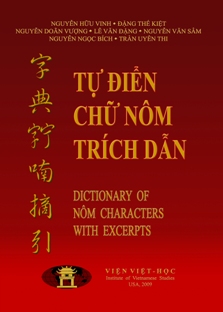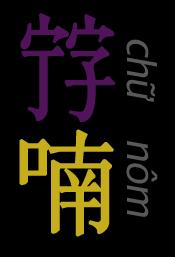 On the occasion of the Ất Dậu Lunar New Year (2005), the Institute of Vietnamese Studies (Viện Việt-học), a California-based institution, made public a first online version of the Tự Điển Chữ Nôm Trích Dẫn(1) (“Dictionary of Nôm Characters with Excerpts”). After further intensive revisions, this dictionary was published four years later (2009) in a handsome hardbound, 1700-page paper edition.
On the occasion of the Ất Dậu Lunar New Year (2005), the Institute of Vietnamese Studies (Viện Việt-học), a California-based institution, made public a first online version of the Tự Điển Chữ Nôm Trích Dẫn(1) (“Dictionary of Nôm Characters with Excerpts”). After further intensive revisions, this dictionary was published four years later (2009) in a handsome hardbound, 1700-page paper edition.
This landmark work was the culmination of a collective effort by seven(2) (initially ten) overseas Vietnamese scholars who labored night and day for nearly a decade, working via the Internet to complete it. It can be stated right here that without the marvelous existence of the Internet, such an international collaborative effort would simply not be possible. The final product, therefore, can be said to be a combination of factors: (1) dedicated Nôm scholars; (2) availability of original Nôm texts found in western and Japanese libraries(3), which never before have been vetted together; (3) invention of a keyboard(4) which could be used to produce Nôm characters; (4) a rational cooperative framework, which amounted to a division of labor acceptable to everyone involved; (5) decision by majority rule in case of conflicting interpretations; and (6) the miraculous flexibility of the computer which allows one to try and shift between different databases.(5)
It should be said that the “excerpts” mentioned in the name of the dictionary all come, without exception, from actual original Nôm texts, i.e. they are attested forms reflecting accurately how these characters were written at different stages in the history of the Nôm script.(6) In other words, there simply is no Nôm character in the dictionary invented by the compilers.
The oldest Nôm texts used for vetting date back only to the eighteenth century but some of these are reprints of much older materials. For instance, some texts found in the Thiền-tông bổn-hạnh 1745 edition actually date from the Trần dynasty (13th-14th centuries). Or the 1761 edition of Chỉ nam ngọc-âm giải nghĩa, a Chinese-Nôm dictionary, apparently is for the most part a reprint of a Hồ dynasty(7) (early 15th century) work, which was sanctioned by the Ming occupation forces (“Minh-giám-bản”) while they were in Vietnam (1407-1427). Another manuscript, the Buddhist scripture Phật thuyết Đại-báo Phụ mẫu ân trọng Kinh, is recently suspected by a Nôm scholar (Nguyễn Quang Hồng(8)), on the basis of its archaic forms, to possibly date back to even the 12th century, hence it is likely a Lý dynasty Nôm text.
Thus, the Tự Điển Chữ Nôm Trích Dẫn can be said to contain nothing but attested forms of Chữ Nôm characters from the 12th century all the way to the 1930’s, a tradition of some eight centuries of a character script different from but still based on the Chinese writing system. And as a dictionary it is a remarkable contribution to the history of Vietnamese lexicography, the last in a long line of distinguished Chữ Nôm dictionaries dating back at least 600 years(9) since Chỉ nam ngọc-âm giải nghĩa is now thought to be a work first published in 1401.
Nguyễn Ngọc Bích
Springfield, VA
October 9, 2010

Notes
- Tự Điển Chữ Nôm Trích Dẫn (“Dictionary of Nôm Characters with Excerpts”), Westminster, California: Viện Việt-Học, 2009, xxv + 1679 pages.
- The seven persons listed as authors are: Nguyễn Hữu Vinh (Taiwan), Đặng Thế Kiệt (France), Nguyễn Doãn Vượng (San Jose, CA), Lê Văn Đặng (Seattle, WA), Nguyễn Văn Sâm (Port Arthur, TX), Nguyễn Ngọc Bích (Springfield, VA), and Trần Uyên Thi (Centreville, VA). Two authors named in the preface but who chose to withdraw from the project are: Alexandre Lê in France and Hạt Cát (Trần Bạch Vân) in the U.S. But their contributions are fully acknowledged.
- This is a most original idea since most of the Nôm dictionaries compiled in Vietnam are based on original Nôm texts found for the most part in-country. In this way, the Tự Điển Chữ Nôm Trích Dẫn is complementary to its peers published inside Vietnam. It also shows that it is perfectly possible to do Nôm studies outside of Vietnam if one puts one’s mind to it.
- The credit for this invention goes to Trần Uyên Thi, the youngest and the only woman author among the seven.
- It is this flexibility which allows for a very powerful search engine, especially in the online version found in www.viethoc.org: a Nôm character can be found listed alphabetically (according to its Quốc-ngữ, or romanized, rendering) if one already knows how it is pronounced; by radical + number of strokes as in a Chinese dictionary; by total number of strokes if one is uncertain about its radical; and by a combination of elements found in it (for instance, one form of the character “tôi” [for “I”] can be found by listing its combination elements, “thạch” [= stone] and “tốt” [= soldier]).
- For example, the word which today is pronounced “trái” (= fruit) was written as two characters “ba-lái” in the 12th-14th century, a combined character “ba+lái” in the fifteenth century (which is essentially a phonetic rendering and probably pronounced close to “blái” as found in Alexandre de Rhodes’ 1651 Dictionarium annamiticum, lusitanum et latinum, published in Roma a century and a half later), then a combined character consisting of “quả” (= fruit, the semantic component) + “lại” (rough phonetic rendering, hinting to its pronunciation). By the 18th and 19th centuries, this combination of the semantic component + the phonetic component became standard in the composition of the vast majority of Chữ Nôm characters.
- Thesis of Mr. Ngô Đức Thọ who based his conclusion on the taboo characters (“chữ húy”) found in the text. He established that the taboo characters found in Chỉ nam ngọc-âm giải nghĩa belong to the reign of Hồ Hán Thương (1401-1407) whose name at birth was Hỏa. (PGS-TS Ngô Đức Thọ, “Thông tin mới nhất về Chỉ nam ngọc-âm” in Thời đại mới số 5, tháng 7/2005)
- Dr. Nguyễn Quang Hồng of the Hán-Nôm Institute in Hanoi presented his view on this question at a small international conference on Nôm studies held at Temple University on April 11 and 12, 2008. By studying the text of Phật thuyết Đại-báo Phụ mẫu ân trọng Kinh, he found 74 cases where a monosyllabic word today was written as two separate syllables (104 instances altogether) and 63 cases where a monosyllabic word today was also written as one character but in which the initial consonantal cluster is clearly recorded (100 instances), i.e. a purely phonetic recording. From this he concludes that this text is even older than the extant 13th century phú from the Trần dynasty and that it possibly could date from the 12th century, i.e. it is a clear case of Lý dynasty Chữ Nôm. (See Tâm Việt, “Hội-nghị Nôm-học ở Temple U, Phila,” published in many Vietnamese-language newspapers in the U.S. on or around April 17, 2008)
- See my much fuller discussion of the history of Vietnamese lexicography in Nguyễn Ngọc Bích, “Tự Điển Chữ Nôm Trích Dẫn hay là bộ tự-điển chữ Nôm đầu tiên đặt trên cơ-sở lịch-sử” (“Tự Điển Chữ Nôm Trích Dẫn or the first Nôm dictionary based on historical principles”).










































